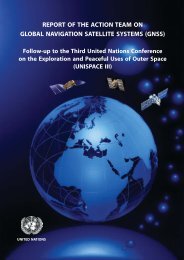What We Can Do for Capacity Building in Space Science and ...
What We Can Do for Capacity Building in Space Science and ...
What We Can Do for Capacity Building in Space Science and ...
- No tags were found...
You also want an ePaper? Increase the reach of your titles
YUMPU automatically turns print PDFs into web optimized ePapers that Google loves.
University <strong>Space</strong> Eng<strong>in</strong>eer<strong>in</strong>g Consortium(UNISEC)Rei Kawashimarei@unisec.jp
Contents• Introduction• Who are we? (UNISEC)• <strong>What</strong> we offer <strong>for</strong> <strong>Capacity</strong> build<strong>in</strong>g:• Nano-satellite Mission Idea Contest (MIC)• <strong>Can</strong>sat Leader Tra<strong>in</strong><strong>in</strong>g Program (CLTP)• Nano-satellite Symposium• UN/Japan <strong>Do</strong>ctr<strong>in</strong>e Program (Scholarship)• Conclusion
UNISEC: University <strong>Space</strong>Eng<strong>in</strong>eer<strong>in</strong>g Consortium• UNISEC is a non-profitable organization to facilitate<strong>and</strong> promote practical space development activities,such as design<strong>in</strong>g, develop<strong>in</strong>g, manufactur<strong>in</strong>g, <strong>and</strong>launch<strong>in</strong>g small satellites <strong>and</strong> hybrid rockets atuniversity level.• Established <strong>in</strong> 2002• 55 laboratories/groups from 35 universities• 470 student members <strong>and</strong> 220 supporters• 3 pillars: Human resource development,Technological development, Outreach
Background (1) <strong>Can</strong>Sat 1998~Thanks toProf. Bob Twiggs!
<strong>Can</strong>Sats<strong>Can</strong>Sats 1999-Feb, 2010
Background (2) CubeSat 1999~• First CubeSat launch (June 2003)• Two Japanese CubeSats (one by Univ. of Tokyo, <strong>and</strong> theother by Tokyo Inst. of Tech.) worked well.• Both satellites are still very healthy <strong>in</strong> orbit (more than 8years)• A total of 15 Japanese university nano satelliteswere launched up to now.First CubeSatLeft: XI-IV by Univ. of TokyoRight: CUTE-I by Tokyo Inst.of Tech.
UNISEC Satellites DevelopmentThe University of TokyoXI-ⅣTokyo Institute of TechnologyCute-ⅠNihon UniversitySEEDS(FM1)HokkaidoInstitute ofTechnologyHITSATXI-ⅤThe University of TokyoCute-1.7 +APDTokyo Institute ofTechnology2003200520062008 20092010JuneNov.Feb.JulySept. Apr. Apr. MayNihon UniversitySEEDS(FM2)Tohoku UniversitySPRITE-SATUNITEC-1UNISECCute-1.7 +APDTokyo Institute ofTechnologyPRISMThe Universityof TokyoSTARSKagawa UniversityKKS-1TokyoMetropolitanCollege OfIndustrialTechnologyWASEDA-SAT2Waseda UniversityKSATKagoshimaUniversityNegai☆”Soka University
UNISEC DevelopmentNumber of Member Laboratories44495455389182328’01 ‘02 ‘03 ‘04 ‘05 ‘06 ‘07 ‘08 ‘09 ‘10July 2011
1) Mission Idea Contest• Objective• Encourage <strong>in</strong>novative exploitation to provide useful <strong>and</strong>susta<strong>in</strong>able capabilities, services or data.• Eligibility• Any <strong>in</strong>dividual, group or company with suitable spacesystems expertise <strong>and</strong> an enthusiasm <strong>for</strong> nano-satellites• Award <strong>for</strong> F<strong>in</strong>alists• Free tickets to Japan• Presentation <strong>in</strong> the Nano-satellite Symposium• High visibility (example: IAA publication)
Results of 1 st Mission Idea Contest• 1st round: extended abstract evaluation step• 62 applications from 24 countries• 10 f<strong>in</strong>alists <strong>and</strong> 5 semi-f<strong>in</strong>alists were selected on Jan 20.F<strong>in</strong>alists: Japan 2, <strong>Can</strong>ada 2, Vietnam 2, UK 1, Turkey 1,Korea 1, USA 1Semi-f<strong>in</strong>alists: Spa<strong>in</strong> 1, South Africa 1, Peru 1, Ukra<strong>in</strong>e 1,USA 1• 2nd round: paper <strong>and</strong> presentation step• 10 f<strong>in</strong>alists made presentation on March 14. (right after theearthquake <strong>in</strong> Japan)
Area Distribution of ApplicantsAfrica!
ReviewersDr. Jerry Sellers(Chair)Teach<strong>in</strong>g<strong>Science</strong> &Technology, Inc.Prof.HermanSteynStellenboschUniv.Prof. Sir Mart<strong>in</strong>Sweet<strong>in</strong>gSSTLSSCDr. MasayaYamamoto<strong>We</strong>athernewsInc.Prof. Sh<strong>in</strong>ichiNakasuka,Univ. ofTokyoDr. Ra<strong>in</strong>erS<strong>and</strong>auDLRProf. HiroshiKawaharaCyber Univ.More reviewers will beannounced
Regional Sem<strong>in</strong>ars <strong>in</strong> 2010Cairo University, EgyptAugust 2, 2010Nairobi University, KenyaOctober 27, 2010Held <strong>in</strong> 16 regions <strong>in</strong> 2010French South AfricanInstitute of TechnologyOctober 28, 2010Use University facility (convenient <strong>and</strong> less expensive),Involve diverse background people (diverse knowledge),Hear from local people who may have real needs (local contact),Motivate students to th<strong>in</strong>k ideas with help of professionals (big team)
World wide network• cc(Currently 22 regions)
Is Lack of Budget a reason ofunproductive loop?No budgetNo projectNo progress
Get out from Unproductive Loopby start<strong>in</strong>g someth<strong>in</strong>g!MoreBudgetNo budgetStart Someth<strong>in</strong>gJo<strong>in</strong> the ContestGet free tickets to JapanAttentionProgress,Motivation,Support,CollaborativeProject
The 2 nd Mission Idea Contest• Objective• Encourage <strong>in</strong>novative exploitation of micro/nano-satellitesto provide useful capabilities, services or data.• 2 Categories:• 1) Mission Idea <strong>and</strong> Satellite Design• 2) Mission Idea <strong>and</strong> Bus<strong>in</strong>ess Model• Target satellite(s): weigh<strong>in</strong>g less than 50 kg,(both constellation mission <strong>and</strong> non-constellation missionare welcome)http://www.spacemic.net
Schedule <strong>for</strong> 2 nd Mission Idea Contest• September 2011 Call <strong>for</strong> Paper• September 2011- April 2012 Regional Sem<strong>in</strong>ar• May 1, 2012 Abstract Deadl<strong>in</strong>e• June 15, 2012 Evaluation Deadl<strong>in</strong>e• July 1, 2012 Announcement of F<strong>in</strong>alist• Sep 1, 2012 F<strong>in</strong>al Paper Deadl<strong>in</strong>e• Oct 10, 2012 F<strong>in</strong>al Presentation at the 4 th Nano-satelliteSymposium (<strong>in</strong> Nagoya)
2) <strong>Can</strong>Sat Leader Tra<strong>in</strong><strong>in</strong>g Program (CLTP)CLTP was established <strong>in</strong> 2011 tocontribute to capacity build<strong>in</strong>g <strong>in</strong>space technology <strong>and</strong> to improveteach<strong>in</strong>g methods-based spaceeng<strong>in</strong>eer<strong>in</strong>g education.• One month course gives tra<strong>in</strong><strong>in</strong>g throughwhole cycle of <strong>Can</strong> Sat development untilsub-orbital launch experiments• Textbook <strong>in</strong> each language will be made asone outcome• Participants are expected to teach <strong>and</strong>promote <strong>Can</strong>Sat experiments <strong>in</strong> theircountries• Aim<strong>in</strong>g <strong>for</strong> <strong>in</strong>ternational <strong>Can</strong>Sat educationnetwork“Give a man a fish <strong>and</strong> youfeed him <strong>for</strong> a day. Teach himhow to fish <strong>and</strong> you feed him<strong>for</strong> a lifetime.”
CLTP 1 <strong>and</strong> CLTP2 <strong>and</strong>….CLTP1held <strong>in</strong> Wakayama Univ. <strong>in</strong> Japan <strong>in</strong> Feb-March2o11, with 12 participants from 10 countries,namely Algeria, Australia, Egypt, Guatemala,Mexico, Nigeria, Peru, Sri Lanka, Turkey, Vietnam.CLTP2will be held <strong>in</strong> Nihon Univ. <strong>in</strong> Nov-Dec 2011 with10 participants from 10 countries, namelyIndonesia, Malaysia, Nigeria, Vietnam, Ghana,Peru, S<strong>in</strong>gapore, Mongolia, Thail<strong>and</strong>, Turkey.CLTP 3 will be announced soon. (Oct-Nov 2012?)http://www.unisec.jp/cltp/en/2nd.htmlhttp://www.cltp.net24
3) The 3 rd Nano-Satellite SymposiumDecember 12 – 13, 2011Kitakyushu,JapanProf. Sh<strong>in</strong>ichi NAKASUKA、ChairpersonNanoJasm<strong>in</strong>The sessions <strong>in</strong>clude:- International Collaboration <strong>in</strong>Micro/NanoSatellite Utilization- International <strong>Capacity</strong> <strong>Build<strong>in</strong>g</strong>Program- Micro/Nano Satellite & DebrisIssues- St<strong>and</strong>ardization of Micro/NanoSatellite Technologies
UN Workshop <strong>and</strong>The 3 rd Nano-Stellite SymposiumThe 4 th Nano-Satellite SymposiumOct. 10-13, 2012NAGOYA, JapanCo-organized by United NationsThe Symposium is held <strong>in</strong> conjunction withJA2012
4)UN/Japan Fellowship Program(Kyushu Institute of Technology)• The United Nations/Japan Long-term FellowshipProgramme on Nano-Satellite Technologies (<strong>Do</strong>ctorate<strong>in</strong> Nano-Satellite Technologies (DNST)" starts onOctober 1 st , 2011. (Egypt <strong>and</strong> Mongolia)• Application fo the next programme will be accepteduntil April 30 th , 2012.• Fellowship Programme details <strong>and</strong> application <strong>for</strong>msare available from:http://www.unoosa.org/oosa/en/SAP/bsti/fellowship.html.
Conclusion: Let’s jo<strong>in</strong> Nano-sat activities!• Lack of Budget?• Participate <strong>in</strong> the Mission Idea Contest <strong>and</strong> explore nano-satellitepotential. If you are lucky, you can get free ticket to Japan.• Lack of Knowledge?• Participate <strong>in</strong> the tra<strong>in</strong><strong>in</strong>g course <strong>and</strong> build your own tra<strong>in</strong><strong>in</strong>gcourse <strong>in</strong> your country.• Lack of Experiences?• Just do it! Then you will have experiences.• Lack of Motivation?• Participate <strong>in</strong> the Symposium, <strong>and</strong> listen to what otherparticipants are do<strong>in</strong>g. You will be energized <strong>and</strong> motivated.• Lack of Confidence?• You are absolutely normal. <strong>Do</strong>n’t worry. Confidence will comeafter you have done it.
Future Vision 2020-100By the end of 2020, we will see the worldwhere university students can participate <strong>in</strong>practical space eng<strong>in</strong>eer<strong>in</strong>g projects <strong>in</strong>more than 100 countries
ContactUNISEC Office2-3-2 Yayoi, Bunkyo-ku, Tokyo,113-0032, JapanTel: +81-3-5800-6645http://www.unisec.jpEmail : e<strong>in</strong>fo@unisec.jp
















